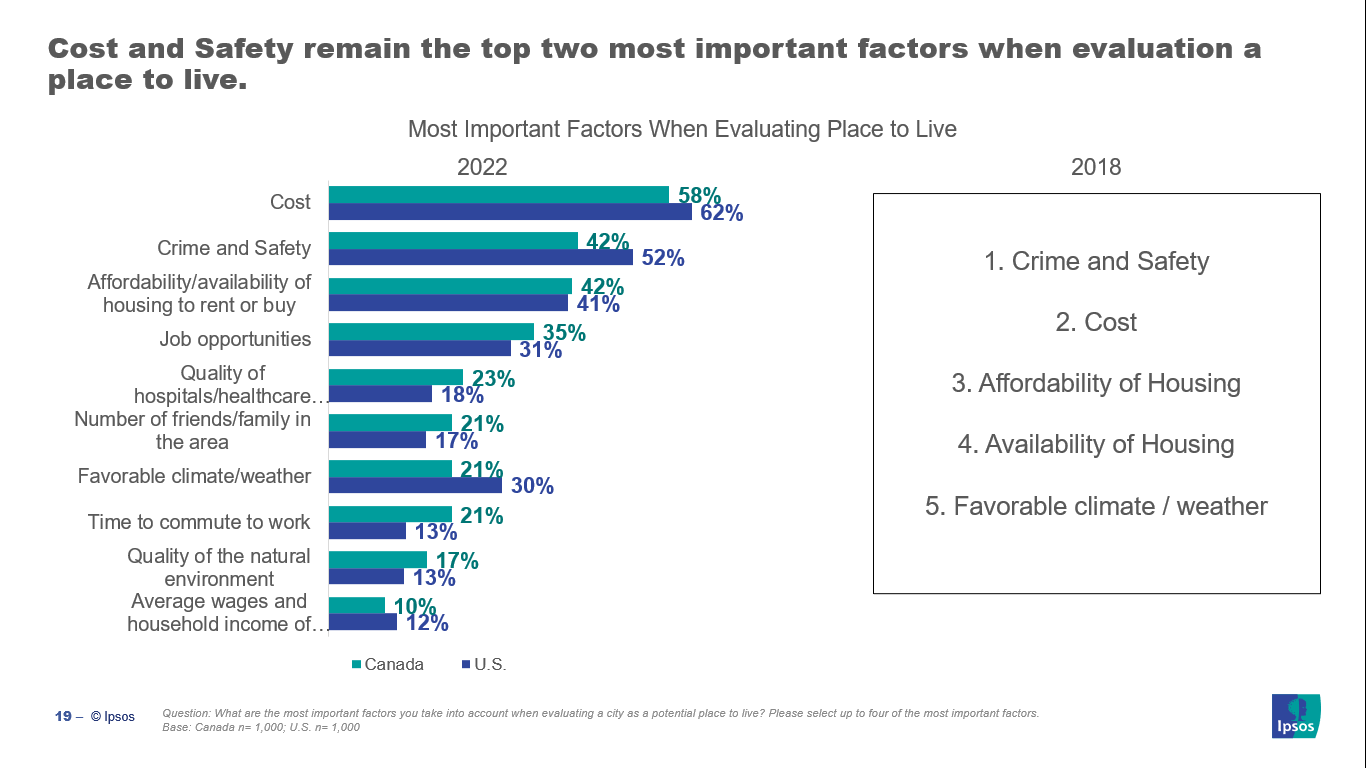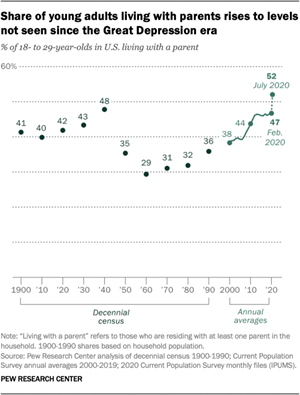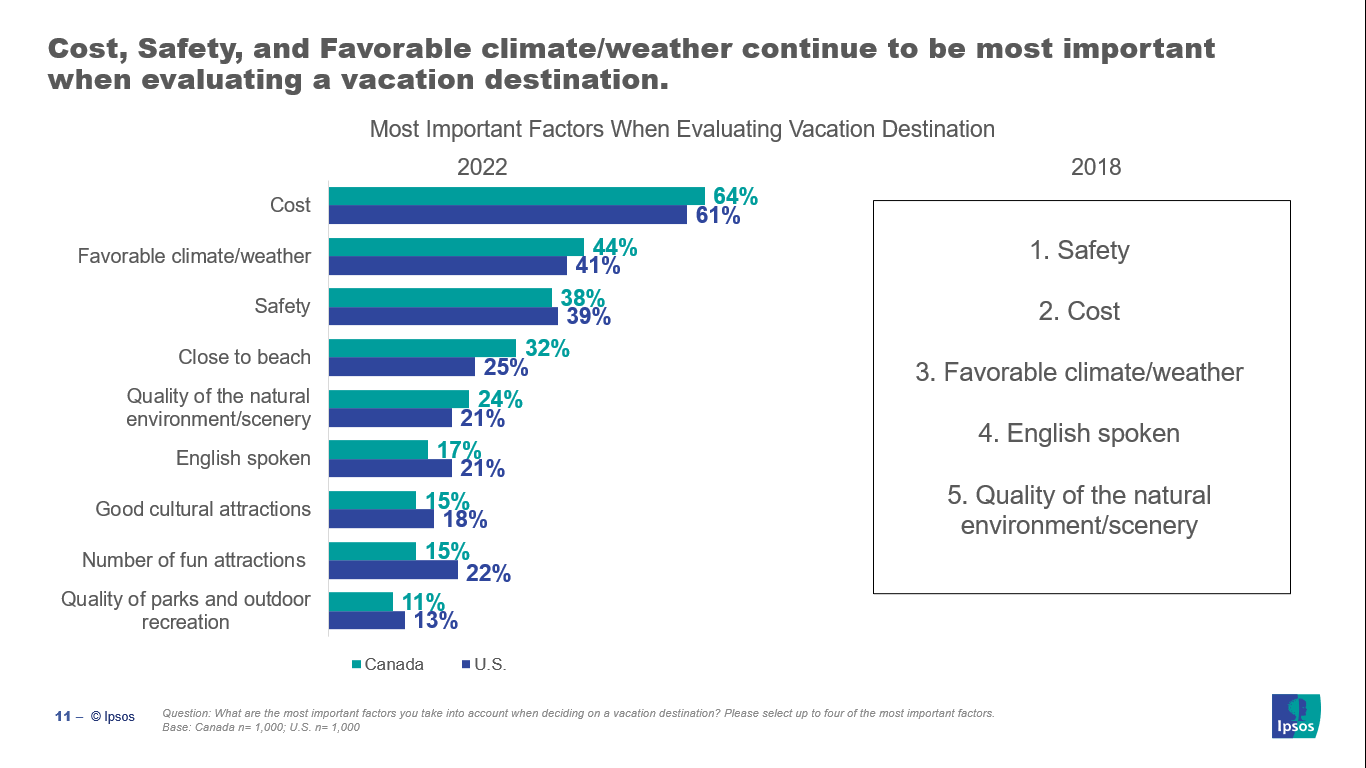What's motivating visitation and relocation post-COVID-19?
After everything that’s happened over the last few years, we began to ask ourselves – what is actually driving people to choose a city or region to visit or live in? Have the motivators for travel and relocation changed at all? Ahead of our City Nation Place Americas conference, our partners at Ipsos have been researching which factors matter most to Americans and Canadians in 2022 when selecting one location from another.
Selecting where to live
What do Americans & Canadians want from the place they live?
Across the board, the most important factors for Americans and Canadians when choosing where to live are cost, crime and safety, affordability / availability of housing, and job opportunities. However, while Canadians selected ‘quality of healthcare’ as the fifth most important factor, Americans preferred ‘favourable climate / weather’ in their choice of hometown.

However, the order of priority shifts when we dive into the demographics. Canadians under 35, or those with children in the household, ranked ‘job opportunities’ as the second most important consideration when selecting where to live, after ‘cost’. Similarly, Americans under 49 years old also rank this as significantly more important than those who are over 50. This is a jump from the national averages, which place job opportunities as the fourth overall priority.
The role of friends and family in settlement decisions
Canadians and Americans ranked the ‘number of family / friends in the area’ as the 6th and 7th most important priorities respectively, highlighting the importance of activating your local community as ambassadors for your place. Just under half of Americans and Canadians live within 50 miles or 50 km of their hometown, with 28% of Americans and 27% of Canadians living within just 10m/km of their hometown.
Amplifying the voices of those who have chosen to relocate to your town from further afield could be a powerful tool to encourage others to move out your way. Take the Western Cape in South Africa, for example. A new campaign from Wesgro [the region’s tourism and trade promotion body] put the spotlight on ‘Neverending Tourists’ – individuals who visited the Western Cape from the Netherlands, UK, and Germany, and never left having fallen in love with the area.
The campaign highlighted the area’s best assets through the honest voice of those who had already made the journey themselves. Uprooting yourself from your community means losing your safety net: showcasing how others have successfully made the transition could help make your city seem more attainable to those who live further afield.
Access to opportunities
 We’ve already shared that just over a quarter of Americans and Canadians live within 10m/km of their hometown, and some of this could be to do with the opportunities available. Ipsos found that those under 35 are significantly more likely to be living within 10m/km of their hometown than other demographics – but this could be due to the fact that they’re still living at home. In July 2020, Pew Research Center found that 52% of young adults resided with one of both of their parents, a sharp rise from 47% in February just a few months prior.
We’ve already shared that just over a quarter of Americans and Canadians live within 10m/km of their hometown, and some of this could be to do with the opportunities available. Ipsos found that those under 35 are significantly more likely to be living within 10m/km of their hometown than other demographics – but this could be due to the fact that they’re still living at home. In July 2020, Pew Research Center found that 52% of young adults resided with one of both of their parents, a sharp rise from 47% in February just a few months prior.
Americans with low to medium income or education were also more likely to live within 10 miles of their hometown, in contrast to those with high income or education, which again could be caused by a lack of opportunities. Adults aged 18 to 34 are more likely to value job opportunities over affordability and availability of housing when evaluating a place to live in. As they’re more likely to be seeking new opportunities, this demographic could be a prime target for messaging that encourage them to locate in your community – particularly in tandem with a strategy that aims to open doors for people of all backgrounds.
Selecting where to vacation
What do Americans & Canadians want from a holiday destination?
When selecting the next location for a holiday, the top four factors for both Americans and Canadians are cost, favourable climate / weather, safety, and closeness to the beach. However, while most Canadians rank ‘quality of natural environment / scenery’ as the next priority, Americans – and Canadians with children in their household – preferred ‘fun attractions’ in their holiday destinations.
This is a shift from 2018, where safety topped out as the primary concern for people looking for a holiday. With ‘cost’ now the number one priority, it could be indicative of people being more cautious with their money following the uncertainty of recent years.

If travellers have less disposable money available, destinations should think about whether they want to aim for quantity or quality in their tourism strategy. For example, do you target a high volume of travellers looking for short, affordable city breaks, or aim for longer, more in-depth stays in your city? And how do you balance your domestic audience within this? If people have less money, visiting family will likely still be a priority – perhaps at the expense of other holidays.
How are people making decisions about holiday locations?
Canadians and Americans both cite family and friends as their top source when deciding where to go on holiday – and this is ranked significantly higher than any other factor (63% and 57% respectively). Word of mouth is critical - so given that people may be looking for lower-cost holidays, how can you empower your local communities as ambassadors for shorter-term stays. Marketing to your domestic audience helps to ensure that your community understand what attractions are on offer when their family comes to stay – and could even encourage them to make more use of what’s in their backyard with day trips!
Following that, top sources are booking websites for Canadians (27%) and destination websites for Americans (30%), so taking the time to refresh your online web presence to reflect the current priorities people are looking for will likely be worthwhile. Those under 35 are significantly more likely to be getting information on vacation destinations online – including social media posts by family, blogs / influencers, and online peer reviews and rating. Addressing these areas will be crucial as Gen Z and Gen Alpha become more important players in the decision-making process.
Finding that secret ingredient
Building a place that people like to live in will further your aims – your community can be a powerful force in encouraging friends and family to relocate or visit an area. But in terms of promoting your place, you have to develop a communication strategy that’s authentic. When you have a real understanding of your place’s assets and also your place’s personality, you can be confident in taking risks to stand out from the crowd.
Visit Winona, for example, launched a quirky campaign that played on a local joke that Winona is the ‘Miami of Minnesota’. “Winona is the warmest place in Minnesota,” shared Cynthya Porter, Marketing Specialist at Visit Winona. “We like to think that our extra three degrees (on average) makes us a little extra balmy here… When it’s zero degrees, we’ll take anything, right?”
Yes, the current priorities for a holiday destination are cost, favourable climate, safety, and beaches, but if every destination was pushing these factors, tourism marketing would quickly start to look very cookie-cutter. The same is true for all place marketing; you need to find that individual flavour that really makes you stand out from the crowd.
Thank you to our partners at Ipsos for sharing this research with us. Book your place at City Nation Place Americas this May 11-12 to join Ipsos’s Moriya Frankel as she dives deeper into the data to help you create the ideal place attractiveness proposition. Find out more about City Nation Place Americas here.









